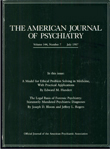I read Dr. Easson's first book,
The Severely Disturbed Adolescent (
1), about three decades ago when I was working on my child and adolescent psychiatric fellowship. It was a book that he would later describe as having written itself. As I reviewed this 1996 book, I had a strange feeling that I was witnessing some sort of somniloquy, an “autographia,” if you will, a soliloquy of someone in a non-REM stage of sleep. And I felt sad, because I loved that first book so. I received this book the day I had to be hospitalized for a “stroke.” With all that time off from the rigors of practice, I had the luxury of hearing an esteemed colleague ruminate. On second and third reading, however, it occurred to me that I somehow never knew who his intended audience was. And it occurred to me that viewing the movie
Titanic would be different from the point of view of a survivor of the shipwreck than for anyone else. Being in private practice for as long as I have changes one's paradigm and reading habits.
This book has 10 chapters. There are 353 pages with nary a picture, graph, or table. One gets the feel of a tour of a revered institution for adolescents with emotional problems in a crisp, avuncular Walter Cronkite documentary that lasts about 90 minutes: cozy, sincere, and measured in cadence. Herein lies the problem, as was the case when “Uncle Walter” rattled off the daily body count in the Vietnam conflict. The viewer who had been in Danang sensed that something was missing. In this book, a lot is missing.
First is an accounting of just how successful the strategies described worked for Dr. Easson's charges. If the reader is to accept his paradigm and method of managing disturbed adolescents, data on patient outcome would be useful. Second, with the mass closings of residential treatment institutions and with managed care looking over our shoulders, how can we proceed at such a slow pace? Third, maybe some more attention should be devoted to this decade's Patuxent-inspired guidelines on the use of restraints and “time outs,” as well as the right to refuse treatment. Finally, as much emphasis as is given to milieu therapy, there needs to be more discussion of issues surrounding hiring and training of staff, especially those who may be transient. Most of the people who apply for these fairly low-paying, high-turnover jobs in my part of the country are college students or college graduates caught in the hiatus between leaving home and landing more permanent jobs elsewhere. How about burnout issues and interpersonal conflicts and how they adversely affect the shifting patient population? Dr. Easson makes a point of the staff sharing meals with the patients; how about each individual staff member's personal attitudes and cultural or subcultural issues surrounding meals and working?
Dangerously bordering on a logical fallacy called the “argument of the beard,” amid a steady flow of good, conventional clinical wisdom are peppered statements that are not supported by the scientific body of data pertinent to such offhand comments. For instance, referring to a fairly anecdotal 1994 case study by Tinsley et al. in the Proceedings of the Mayo Clinic about possible abuse of a selective serotonin reuptake inhibitor, Dr. Easson says, “Recent reports have suggested some risk of abuse because of the stimulant effect.” And, “Antidepressants . . . are used frequently for the treatment of depressive symptoms in teenagers. Though no [my italics] controlled studies show these medications to be superior in therapeutic effect to placebo.”
Other troubling statements include the following: “Hypomanic or manic symptoms may be precipitated in youngsters who go on [my italics] to develop bipolar disorder.” “Adolescents, especially younger teenagers, are normally moody. Depressed youngsters may be more moody, but this moodiness is likely to be a quieter, more subdued moodiness (`she keeps to herself,' `she has become a very private person'). Unlike the depressed suicidal adolescent, the youngster with elevated mood is less likely to do something that will force the attention of the family or the community.”
It could be that Dr. Easson's and my practice patterns are, indeed, worlds apart because he has more administrative staff without the individual, group, and family therapy that I do, but we seem to see adolescent psychiatry from slightly different perspectives. Nonetheless, one consistent leitmotif shines through this and his first book: here is a man of massive compassion and generosity of spirit. As Rachel Naomi Remen, M.D., said in
Kitchen Table Wisdom (
2), no human story is invalid or a lie. Each story is valid and true. And instructional. As the Buddha said, “When the student is ready, a teacher always appears.” Dr. Easson's book is full of instructional pearls of wisdom culled from years of practice, hearing the stories that make up the multipatterned, multicolored quilt of the human experience. It is a story worth taking in, like a fireside chat with someone who has been through “the wars” who can still chuckle with the reminiscing.

